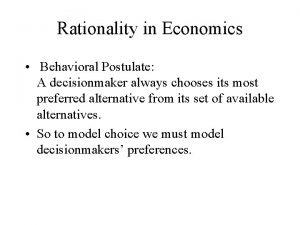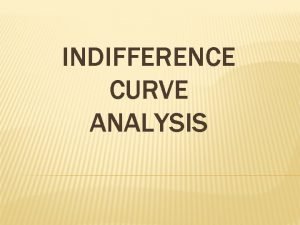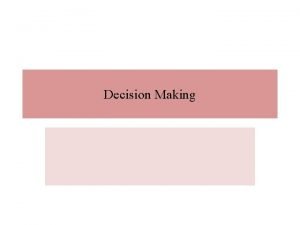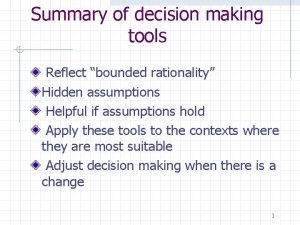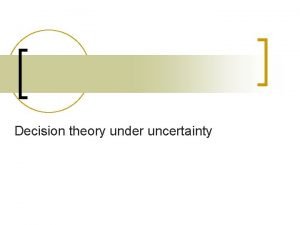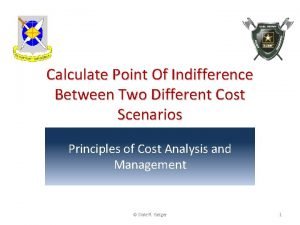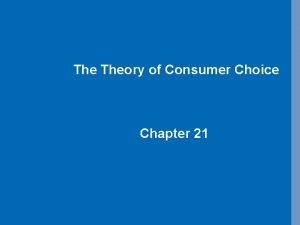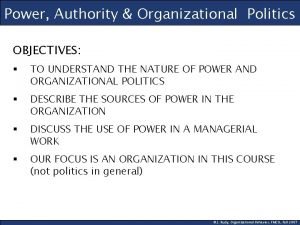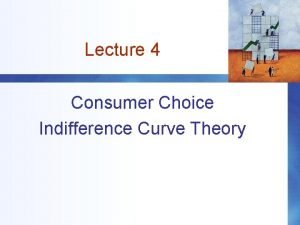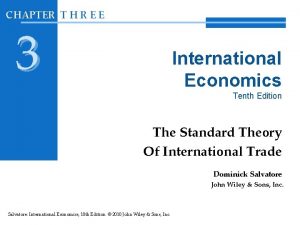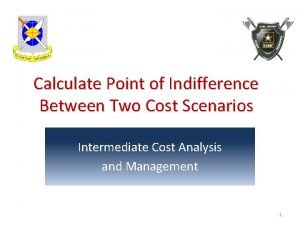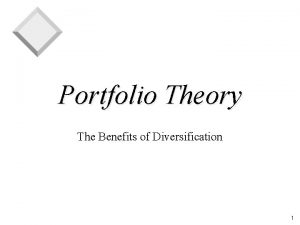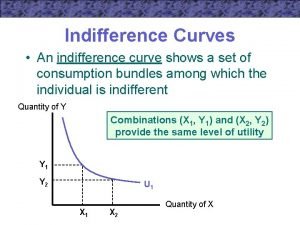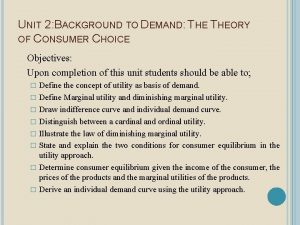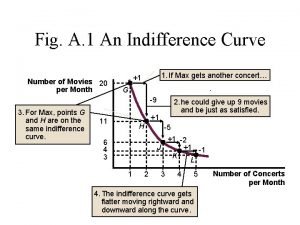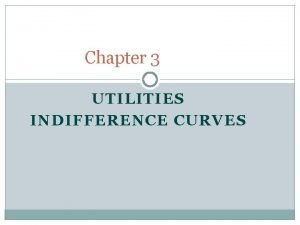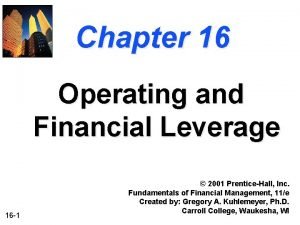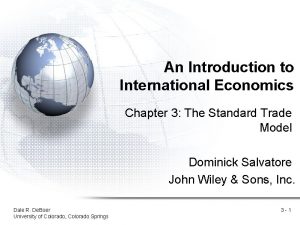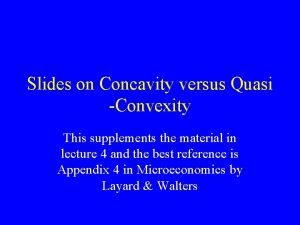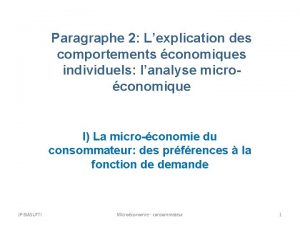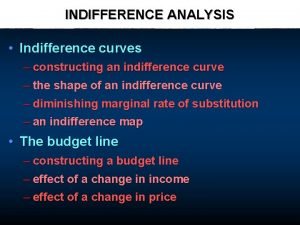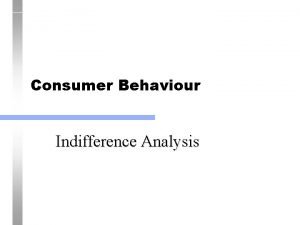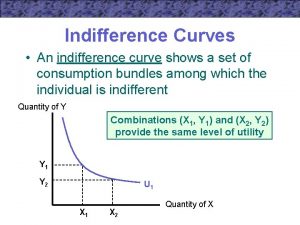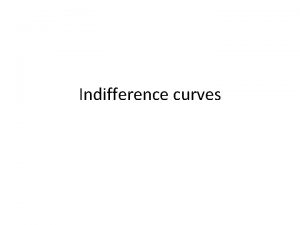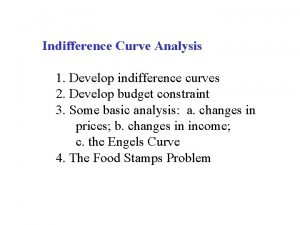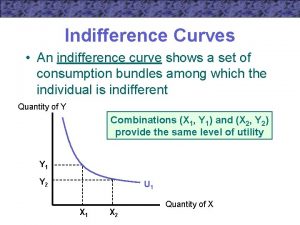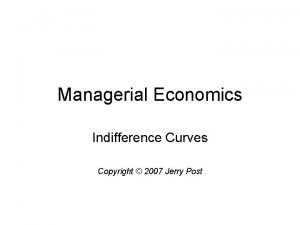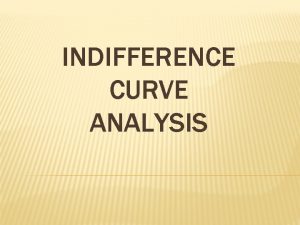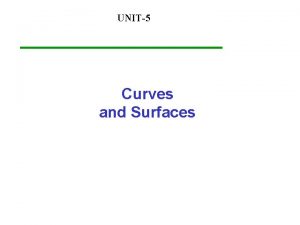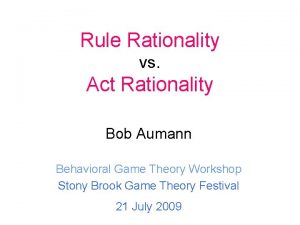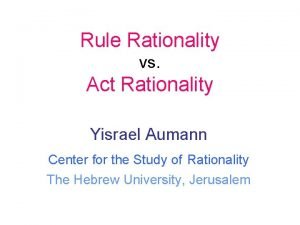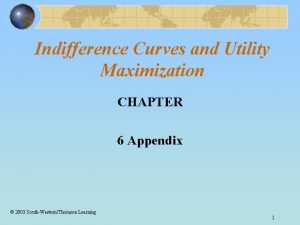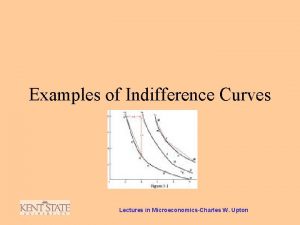TastesPreferences Indifference Curves Rationality in Economics u Rationality






































- Slides: 38

Tastes/Preferences Indifference Curves

Rationality in Economics u Rationality Behavioral Postulate: “Rational Economic Man” The decision-maker chooses the most preferred bundle from the set of available bundles. u We must model: Set of available bundles; and The decision-maker’s preferences.

PREFERENCES X is the bundle (x 1, x 2) and Y is the bundle (y 1, y 2) Weakly preferred Bundle X is as least as good as bundle Y (X Y) ~ Indifferent Bundle X is equivalent to bundle Y (X ~ Y) Strictly preferred Bundle X is preferred to bundle Y (X > Y)

PREFERENCES: Axioms 1. Completeness {A B or B A or A ~ B} Any two bundles can be compared. 2. Reflexive {A A } Any bundle is at least as good as itself. 3. Transitivity {If A B and B C then A C} Non-satiation assumption (I. e. goods, not bads)

Axioms u Transitivity: If x is at least as preferred as y, and y is at least as preferred as z, then x is at least as preferred as z; i. e. x f y and y f z ~ ~ x fz. ~

PREFERENCES Intransitivity? A>B B>C Starting at C Willing to pay to get to B Willing to pay to get to A Willing to pay to get to C Willing to pay to get to B … “Money Pump” Argument (I. e. proof by contradiction) C>A

INDIFFERENCE CURVES x 2 x 1 x 2 3 x I(x’) The indifference curve through any particular consumption bundle consists of all bundles of products that leave the consumer indifferent to the given bundle. x 1 ~ x 2 ~ x 3 x 1

INDIFFERENCE CURVES x z p p x 2 x z y x 1 y

INDIFFERENCE CURVES I 1 x 2 x z I 2 y I 3 All bundles in I 1 are strictly preferred to all in I 2. All bundles in I 2 are strictly preferred to all in I 3. x 1

INDIFFERENCE CURVES x 2 WP(x), the set of x bundles weakly preferred to x. I(x’) x 1

INTERSECTING INDIFFERENCE CURVES? x 2 I 1 From I 1, x ~ y From I 2, x ~ z Therefore y ~ z? I 2 x y z x 1

INTERSECTING INDIFFERENCE CURVES? x 2 I 1 But from I 1 and I 2 we see y > z. There is a contradiction. I 2 x y z x 1

SLOPES OF INDIFFERENCE CURVES? u When more of a product is always preferred, the product is a good. u If every product is a good then indifference curves are negatively sloped.

SLOPES OF INDIFFERENCE CURVES? Good 2 Be tte r W or se Two “goods” therefore a negatively sloped indifference curve. Good 1

SLOPES OF INDIFFERENCE CURVES? u If less of a product is always preferred then the product is a “bad”.

SLOPES OF INDIFFERENCE CURVES? Good 2 r e t t e B One “good” and one “bad” therefore a positively sloped indifference curve. e s or W Bad 1

PERFECT SUBSITIUTES u If a consumer always regards units of products 1 and 2 as equivalent, then the products are perfect substitutes and only the total amount of the two products matters.

PERFECT SUBSITIUTES x 2 I 2 Slopes are constant at - 1. Examples? I 1 x 1

PERFECT COMPLEMENTS u If a consumer always consumes products 1 and 2 in fixed proportion (e. g. one-to-one), then the products are perfect complements and only the number of pairs of units of the two products matters.

PERFECT COMPLEMENTS x 2 45 o Example: Each of (5, 5), (5, 9) and (9, 5) is equally preferred 9 5 I 1 5 9 x 1

PERFECT COMPLEMENTS x 2 45 o 9 I 2 5 Each of (5, 5), (5, 9) and (9, 5) is less preferred than the bundle (9, 9). I 1 5 9 x 1

WELL BEHAVED PREFERENCES u. A preference relation is “well-behaved” if it is monotonic and convex. u Monotonicity: More of any product is always preferred (i. e. every product is a good, no satiation). u Convexity: Mixtures of bundles are (at least weakly) preferred to the bundles themselves. For example, the 50 -50 mixture of the bundles x and y is z = (0. 5)x + (0. 5)y. z is at least as preferred as x or y.

WELL BEHAVED PREFERENCES Monotonicity u more of either product is better u indifference curves have negative slopes Convexity u averages are preferred to extremes u slopes get flatter as you move further to the right (not obvious yet)

WELL BEHAVED PREFERENCES Convexity x x 2 x+y z= 2 x 2+y 2 2 y y 2 x 1+y 1 2 y 1 z is strictly preferred to both x and y

WELL BEHAVED PREFERENCES Convexity x x 2 z =(tx 1+(1 -t)y 1, tx 2+(1 -t)y 2) is preferred to x and y for all 0 < t < 1. y y 2 x 1 y 1

WELL BEHAVED PREFERENCES Convexity. x x 2 y 2 x 1 Preferences are strictly convex when all mixtures z are strictly z preferred to their component bundles x and y. y y 1

WELL BEHAVED PREFERENCES Weak Convexity x’ z’ x z y Preferences are weakly convex if at least one mixture z is equally preferred to a component bundle, e. g. perfect y’ substitutes.

NON-CONVEX PREFERENCES B x 2 r te et z y 2 x 1 y 1 The mixture z is less preferred than x or y. Examples?

NON CONVEX PREFERENCES B r te et x 2 z y 2 x 1 y 1 The mixture z is less preferred than x or y

SLOPES OF INDIFFERENCE CURVES u The slope of an indifference curve is referred to as the marginal rate-ofsubstitution (MRS). u How can a MRS be calculated?

MARGINAL RATE OF SUBSITITUTION (MRS) x 2 MRS at x* is the slope of the indifference curve at x* x* x 1

MRS x 2 D x 2 x* MRS at x* is lim {Dx 2/Dx 1} as Dx 1 0 = dx 2/dx 1 at x* D x 1

MRS is the amount of product 2 an individual is willing to exchange for an extra unit of product 1 x 2 dx 2 x* dx 1

MRS Good 2 r te et B Two “goods” have a negatively sloped indifference curve MRS < 0 se or W Good 1

MRS Good 2 r e t t e B One “good” and one “bad” therefore a positively sloped indifference curve e s or W MRS > 0 Bad 1

MRS Good 2 MRS = (-) 5 MRS decreases (in absolute terms) as x 1 increases if and only if preferences are strictly convex. Intuition? MRS = (-) 0. 5 Good 1

MRS x 2 MRS = (-) 0. 5 If MRS increases (in absolute terms) as x 1 increases non-convex preferences MRS = (-) 5 x 1

MRS x 2 MRS = - 0. 5 MRS is not always decreasing as MRS = - 1 x 1 increases - non. MRS = - 2 convex preferences. x 1
 Economic rationality
Economic rationality Indifference curve inferior good
Indifference curve inferior good Non programmed decision example
Non programmed decision example Rationality
Rationality Contoh pengambilan keputusan bounded rationality
Contoh pengambilan keputusan bounded rationality Bounded rationality
Bounded rationality A formal organization based on rationality and efficiency
A formal organization based on rationality and efficiency Types of decision making
Types of decision making Rationality through reasoning
Rationality through reasoning Rational decision making model
Rational decision making model Maastricht university school of business and economics
Maastricht university school of business and economics Econ213
Econ213 Uncertain examples
Uncertain examples How to find the indifference point
How to find the indifference point Kurva kepuasan sama (indifference curve) adalah
Kurva kepuasan sama (indifference curve) adalah Budget line and indifference curve
Budget line and indifference curve Zone of indifference in organizational behavior
Zone of indifference in organizational behavior Risk aversion indifference curve
Risk aversion indifference curve La belle indifference definition
La belle indifference definition Consumers indifference map for sneakers and jackets
Consumers indifference map for sneakers and jackets Community indifference curve
Community indifference curve Point of indifference
Point of indifference Curve sighet
Curve sighet Sharpe single index model
Sharpe single index model Convex curve
Convex curve Expressing interest and indifference
Expressing interest and indifference Rgood rx
Rgood rx What is power charge indifference adjustment
What is power charge indifference adjustment Indifference curve of perfect substitutes
Indifference curve of perfect substitutes Seuil d'indifférence calcul
Seuil d'indifférence calcul Indifference curve
Indifference curve Community indifference curve
Community indifference curve Tangent indifference curve
Tangent indifference curve Courbe d'indifférence substituts parfaits
Courbe d'indifférence substituts parfaits Ebit-eps indifference analysis chart is used for
Ebit-eps indifference analysis chart is used for Community indifference curve
Community indifference curve Quasi concave indifference curve
Quasi concave indifference curve Courbe d'indifférence
Courbe d'indifférence An ebit eps indifference analysis chart is used for
An ebit eps indifference analysis chart is used for
